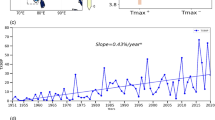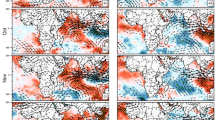Abstract
Many previous studies have documented the changes in rainfall patterns along the Western coast of India. The Western Ghats of India comprising of coastal regions of Maharashtra, Karnataka, and Kerala regions are facing the worst floods and droughts in recent years. Changes in low-level horizontal wind circulation due to the change in sea surface temperature over the northern Arabian Sea have been reported by many studies. This work highlights the role of surface–subsurface variations in temperature over the Arabian Sea in governing rainfall variability over the Western Ghats. The subsurface flow of water masses from the Southern Indian Ocean into the Arabian Sea or vice versa along the Somalia–Oman coast can increase or decrease the depth of the thermocline. Deepening or shoaling of thermocline depth in the central Arabian Sea can further lead to changes in the surface temperatures. The rainfall variability over the Western Ghats is predominantly governed by the sea surface temperature (SST) variations over the Arabian Sea. The shoaling of thermocline due to an increase in Ekman upwelling and decrease in the subsurface water flow has decreased SST in the Arabian Sea in the recent decade. This decrease in SST can lead to a decrease in the rainfall over the Western Ghats. This study also reports an interdecadal oscillation in the surface-subsurface coupling over the Arabian Sea.










Similar content being viewed by others
References
Adler R F, Huffman G J, Chang A, Ferraro R, Xie P P, Janowiak J, Rudolf B, Schneider U, Curtis S, Bolvin D, Gruber A, Susskind J, Arkin P and Nelkin E 2003 The version-2 global precipitation climatology project (GPCP) monthly precipitation analysis (1979-present); J. Hydrometeorol. 4 1147–1167.
Arora A, Rao S A, Chattopadhyay R, Goswami T, George G and Sabeerali C T 2016 Role of Indian Ocean SST variability on the recent global warming hiatus; Glob. Planet. Change 143 21–30.
Ault T R, Cole J E, Overpeck J T, Pederson G T and Meko D M 2014 Assessing the risk of persistent drought using climate model simulations and paleoclimate data; J. Clim. 27 7529–7549.
Balmaseda M A, Mogensen K and Weaver A T 2013 Evaluation of the ECMWF ocean reanalysis system ORAS4; Quart. J. Roy. Meteorol. Soc. 139 1132–1161.
Behringer D W, Ji M and Leetmaa A 1998 An improved coupled model for ENSO prediction and implications for ocean initialization. Part I: The ocean data assimilation system; Mon. Weather Rev. 126 1013–1021.
Brock J C and McClain C R 1992 Interannual variability in phytoplankton blooms observed in the northwestern Arabian Sea during the southwest monsoon; J. Geophys. Res. 97 733–750.
Carton J A, Chepurin G A and Chen L 2018 SODA3: A new ocean climate reanalysis; J. Clim. 31(17) 6967–6983.
Carton J A and Giese B S 2008 A reanalysis of ocean climate using Simple Ocean Data Assimilation (SODA); Mon. Weather Rev. 136 2999–3017.
Carton J A, Giese B S and Grodsky S A 2005 Sea level rise and the warming of the oceans in the Simple Ocean Data Assimilation (SODA) ocean reanalysis; J. Geophys. Res. C Ocean 110 1–8.
Cheng L, Trenberth K E, Fasullo J, Boyer T, Abraham J and Zhu J 2017 Improved estimates of ocean heat content from 1960 to 2015; Sci. Adv. 3(3) e1601545.
Cheng L, Zheng F and Zhu J 2015 Distinctive ocean interior changes during the recent warming slowdown; Sci. Rep. 5 1–11.
de Boyer Montégut C, Madec G, Fischer A S, Lazar A and Iudicone D 2004 Mixed layer depth over the global ocean: An examination of profile data and a profile-based climatology; J. Geophys. Res. C Ocean 109 1–20.
Du Y and Xie S P 2008 Role of atmospheric adjustments in the tropical Indian Ocean warming during the 20th century in climate models; Geophys. Res. Lett. 35(8).
Findlater J 1969 A major low‐level air current near the Indian Ocean during the northern summer; Quart. J. Roy. Meteorol. Soc. 95 362–380.
Fischer A S, Weller R A, Rudnick D L, Eriksen C C, Lee C M, Brink K H, Fox C A and Leben R R 2002 Mesoscale eddies, coastal upwelling, and the upper-ocean heat budget in the Arabian Sea; Deep. Res. Part II Top. Stud. Oceanogr. 49 2231–2264.
Frey B S 2019 UNESCO World Heritage List; In: Economics of Art and Culture (103–113) Springer, Cham.
Gadgil S 2003 The Indian monsoon and its variability; Ann. Rev. Earth Planet. Sci. 31 429–467.
Ghosh S, Luniya V and Gupta A 2009 Trend analysis of Indian summer monsoon rainfall at different spatial scales; Atmos. Sci. Lett. 10(4) 285–290.
Good S A, Martin M J and Rayner N A 2013 EN4: Quality controlled ocean temperature and salinity profiles and monthly objective analyses with uncertainty estimates; J. Geophys. Res. Ocean 118 6704–6716.
Goswami B N 2012 South Asian monsoon, Chapter 2; In: Intraseasonal Variability in the Atmosphere-Ocean Climate System, 2nd edn (eds) Lau W K M and Waliser D, Springer-Praxis, Chichester, UK.
Goswami B N, Venugopal V, Sangupta D, Madhusoodanan M S and Xavier P K 2006 Increasing trend of extreme rain events over India in a warming environment; Science 314 1442–1445.
He Z, Wu R, Wang W, Wen Z and Wang D 2017 Contributions of surface heat fluxes and oceanic processes to tropical SST changes: Seasonal and regional dependence; J. Clim. 30 4185–4205.
Hersbach H and Dee D J E N 2016 ERA5 reanalysis is in production; ECMWF Newslett. 147(7) 5–6.
Izumo T, Montegut C de B, Luo J J, Behera S K, Masson S and Yamagata T 2008 The role of the Western Arabian Sea upwelling in Indian monsoon rainfall variability; J. Clim. 21 5603–5623.
Kosaka Y and Xie S P 2013 Recent global-warming hiatus tied to equatorial Pacific surface cooling; Nature 501 403–407.
Krishnamurthy V and Shukla J 2000 Intraseasonal and interannual variability of rainfall over India; J. Clim. 13 4366–4377.
Kucharski F, Molteni F and Yoo J H 2006 SST forcing of decadal Indian Monsoon rainfall variability; Geophys. Res. Lett. 33.
Kumar S, Hazra A and Goswami B N 2014 Role of interaction between dynamics, thermodynamics and cloud microphysics on summer monsoon precipitating clouds over the Myanmar Coast and the Western Ghats; Clim. Dyn. 43 911–924.
Lee S K, Park W, Baringer M O, Gordon A L, Huber B and Liu Y 2015 Pacific origin of the abrupt increase in Indian Ocean heat content during the warming hiatus; Nat. Geosci. 8 445–449.
Liu W and Xie S P 2018 An ocean view of the global surface warming hiatus; Oceanography 31 72–79.
Maher N, Gupta A Sen and England M H 2014 Drivers of decadal hiatus periods in the 20th and 21st centuries; Geophys. Res. Lett. 41(16) 5978–5986.
Meehl G A, Arblaster J M, Fasullo J T, Hu A and Trenberth K E 2011 Model-based evidence of deep-ocean heat uptake during surface-temperature hiatus periods; Nat. Clim. Chang. 1 360–364.
Ninomiya K and Kobayashi C 1998 Precipitation and moisture balance of the Asian summer monsoon in 1991 part I: Precipitation and major circulation systems; J. Meteorol. Soc. Japan 76 855–877.
Pratik K, Parekh A, Karmakar A, Chowdary J S and Gnanaseelan C 2019 Recent changes in the summer monsoon circulation and their impact on dynamics and thermodynamics of the Arabian Sea; Theor. Appl. Climatol. 136 321–331.
Preethi B, Ramya R, Patwardhan S K, Mujumdar M and Kripalani R H 2019 Variability of Indian summer monsoon droughts in CMIP5 climate models; Clim. Dyn. 53 1937–1962.
Qu T, 2001 Role of ocean dynamics in determining the mean seasonal cycle of the South China Sea surface temperature; J. Geophys. Res. Ocean 106 6943–6955.
Rajeevan M, Gadgil S and Bhate J 2010 Active and break spells of the Indian summer monsoon; J. Earth Syst. Sci. 119 229–247.
Rajendran K, Kitoh A, Srinivasan J, Mizuta R and Krishnan R 2012 Monsoon circulation interaction with Western Ghats orography under changing climate: Projection by a 20-km mesh AGCM; Theor. Appl. Climatol. 110 555–571.
Rakhecha P R and Pisharoty P R 1996 Heavy rainfall during monsoon season: Point and spatial Distribution; Curr. Sci. 71 179–186.
Rao S A, Dhakate A R, Saha S K, Mahapatra S, Chaudhari H S, Pokhrel S and Sahu S K 2012 Why is Indian Ocean warming consistently? Clim. Change 110 709–719.
Revadekar J V, Varikoden H, Murumkar P K and Ahmed S A 2018 Latitudinal variation in summer monsoon rainfall over Western Ghat of India and its association with global sea surface temperatures; Sci. Total Environ. 613–614 88–97.
Roxy M K, Ritika K, Terray P, Murtugudde R, Ashok K and Goswami B N 2015 Drying of Indian subcontinent by rapid Indian ocean warming and a weakening land-sea thermal gradient; Nat. Commun. 6 1–10.
Sayantani O and Gnanaseelan C 2015 Tropical Indian Ocean subsurface temperature variability and the forcing mechanisms; Clim. Dyn. 44 2447–2462.
Schott F A, Xie S P and McCreary J P 2009 Indian ocean circulation and climate variability; Rev. Geophys. 47(1).
Solomon S, Rosenlof K H, Portmann R W, Daniel J S, Davis S M, Sanford T J and Plattner G K 2010 Contributions of stratospheric water vapor to decadal changes in the rate of global warming; Science 327 1219–1223.
Su H, Wu X, Lu W, Zhang W and Yan X H 2017a Inconsistent Subsurface and Deeper Ocean Warming Signals During Recent Global Warming and Hiatus; J. Geophys. Res. Ocean 122 8182–8195.
Su J, Zhang R and Wang H 2017b Consecutive record-breaking high temperatures marked the handover from hiatus to accelerated warming; Sci. Rep. 7(1) 1–9.
Swapna P, Jyoti J, Krishnan R, Sandeep N and Griffies S M 2017 Multidecadal Weakening of Indian Summer Monsoon Circulation Induces an Increasing Northern Indian Ocean Sea Level; Geophys. Res. Lett. 44 10,560-10,572.
Varikoden H, Revadekar J V, Kuttippurath J and Babu C A 2019 Contrasting trends in southwest monsoon rainfall over the Western Ghats region of India; Clim. Dyn. 52 4557–4566.
Vecchi G A and Harrison D E 2004 Interannual Indian rainfall variability and Indian ocean sea surface temperature anomalies; Earth Climate: The Ocean–Atmosphere Interaction, Geophys. Monogr. 147 247–260.
Xie S P, Annamalai H, Schott F A and McCreary J P 2002 Structure and mechanisms of South Indian Ocean climate variability; J. Clim. 15 864–878.
Xie S P, Lu B and Xiang B 2013 Similar spatial patterns of climate responses to aerosol and greenhouse gas changes; Nat. Geosci. 6 828–832.
Acknowledgements
Authors thank the Director IITM for his full support. Authors thank NCAR for making available the NCL software. All the data sources are duly acknowledged. Indian Institute of Tropical Meteorology (IITM) is fully funded by the Ministry of Earth Sciences (MoES), Government of India, New Delhi. Pratyush HPC facility at IITM is duly acknowledged.
Author information
Authors and Affiliations
Contributions
Anika Arora carried out all the work related to this manuscript.
Corresponding author
Additional information
Communicated by Kavirajan Rajendran
Rights and permissions
About this article
Cite this article
Arora, A. On the role of the Arabian Sea thermal variability in governing rainfall variability over the Western Ghats. J Earth Syst Sci 130, 117 (2021). https://doi.org/10.1007/s12040-021-01615-0
Received:
Revised:
Accepted:
Published:
DOI: https://doi.org/10.1007/s12040-021-01615-0




